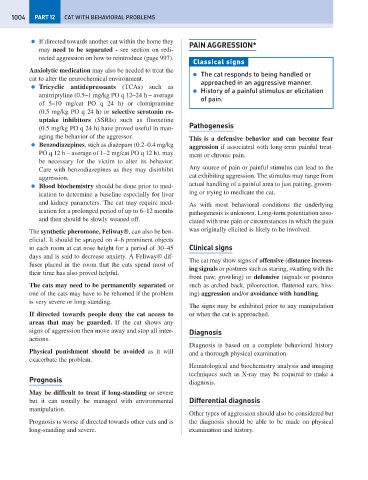Page 1012 - Problem-Based Feline Medicine
P. 1012
1004 PART 12 CAT WITH BEHAVIORAL PROBLEMS
● If directed towards another cat within the home they
PAIN AGGRESSION*
may need to be separated - see section on redi-
rected aggression on how to reintroduce (page 997).
Classical signs
Anxiolytic medication may also be needed to treat the
● The cat responds to being handled or
cat to alter the neurochemical environment.
approached in an aggressive manner.
● Tricyclic antidepressants (TCAs) such as
● History of a painful stimulus or elicitation
amitriptyline (0.5–1 mg/kg PO q 12–24 h – average
of pain.
of 5–10 mg/cat PO q 24 h) or clomipramine
(0.5 mg/kg PO q 24 h) or selective serotonin re-
uptake inhibitors (SSRIs) such as fluoxetine
Pathogenesis
(0.5 mg/kg PO q 24 h) have proved useful in man-
aging the behavior of the aggressor. This is a defensive behavior and can become fear
● Benzodiazepines, such as diazepam (0.2–0.4 mg/kg aggression if associated with long-term painful treat-
PO q 12 h – average of 1–2 mg/cat PO q 12 h), may ment or chronic pain.
be necessary for the victim to alter its behavior.
Care with benzodiazepines as they may disinhibit Any source of pain or painful stimulus can lead to the
aggression. cat exhibiting aggression. The stimulus may range from
● Blood biochemistry should be done prior to med- actual handling of a painful area to just patting, groom-
ication to determine a baseline especially for liver ing or trying to medicate the cat.
and kidney parameters. The cat may require med- As with most behavioral conditions the underlying
ication for a prolonged period of up to 6–12 months pathogenesis is unknown. Long-term potentiation asso-
and then should be slowly weaned off. ciated with true pain or circumstances in which the pain
The synthetic pheromone, Feliway®, can also be ben- was originally elicited is likely to be involved.
eficial. It should be sprayed on 4–6 prominent objects
in each room at cat nose height for a period of 30–45 Clinical signs
days and is said to decrease anxiety. A Feliway® dif-
The cat may show signs of offensive (distance increas-
fuser placed in the room that the cats spend most of
ing signals or postures such as staring, swatting with the
their time has also proved helpful.
front paw, growling) or defensive (signals or postures
The cats may need to be permanently separated or such as arched back, piloerection, flattened ears, hiss-
one of the cats may have to be rehomed if the problem ing) aggression and/or avoidance with handling.
is very severe or long-standing.
The signs may be exhibited prior to any manipulation
If directed towards people deny the cat access to or when the cat is approached.
areas that may be guarded. If the cat shows any
signs of aggression then move away and stop all inter- Diagnosis
actions.
Diagnosis is based on a complete behavioral history
Physical punishment should be avoided as it will and a thorough physical examination.
exacerbate the problem.
Hematological and biochemistry analysis and imaging
techniques such as X-ray may be required to make a
Prognosis diagnosis.
May be difficult to treat if long-standing or severe
but it can usually be managed with environmental Differential diagnosis
manipulation.
Other types of aggression should also be considered but
Prognosis is worse if directed towards other cats and is the diagnosis should be able to be made on physical
long-standing and severe. examination and history.

